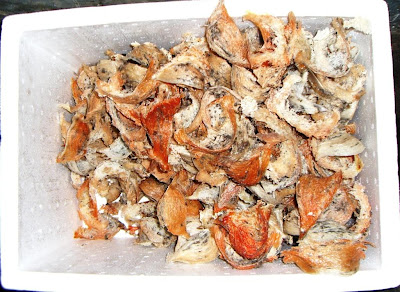 DOUBLE CLICKS FOR MORE DETAILS
DOUBLE CLICKS FOR MORE DETAILSIf you look closely inside the above container you realised that those red nests are not 100% red.
Those nests were harvested from a BH in Central Java.
They are red on the outer surface layer but inside they are still white.
Let us try to examine those myth that people used to spread around about red nests:
a) The were red saliva of the birds?
If that is so how come the inside are not red? Just imagine if the saliva were red the moment those swiftlet built their nests the total nest must be the same color.
b) The red color have something to do with those walls.
Again this is not true. The point of contact in a BH will be the nesting planks. Nesting planks are normally made of wood. Wood normally do not produce any metal like those in the cave.
c) The red color must have something with the room environment.
This might be the best guess. If we look carefully the red color will start from the outside. The surface area are exposed to the water in the air plus the ammonia concentration.
The house was said to be almost 20 years old. The owner keep those bird shits on the floor to almost a foot deep, accoding to the visitor. You need to wear a gas mask if you want to stay long in the BH.
The moment the humidity, temperature and the ammonia concentration are perfect the discoloration process will begins. First the white outer surface will turned light yellow and then darker yellow then red. The red coloration will continue until the nest will become red hot and if you do not harvest on time they will turn black.
How come the inside are not turning red as fast as the outside? Well since the mother birds incubate the eggs and once hatch the young babies sit in the nest, the internal surface do not come into direct contact with the ammonia gas.
The above explanation came from the person who entered the house and was very sure that the redness was due to the thick ammonia gas and the right humidity in the nesting room.
I believed in him but maybe there are others who might have some other explanations.

They are red on the outer surface layer but inside they are still white.
Let us try to examine those myth that people used to spread around about red nests:
a) The were red saliva of the birds?
If that is so how come the inside are not red? Just imagine if the saliva were red the moment those swiftlet built their nests the total nest must be the same color.
b) The red color have something to do with those walls.
Again this is not true. The point of contact in a BH will be the nesting planks. Nesting planks are normally made of wood. Wood normally do not produce any metal like those in the cave.
c) The red color must have something with the room environment.
This might be the best guess. If we look carefully the red color will start from the outside. The surface area are exposed to the water in the air plus the ammonia concentration.
The house was said to be almost 20 years old. The owner keep those bird shits on the floor to almost a foot deep, accoding to the visitor. You need to wear a gas mask if you want to stay long in the BH.
The moment the humidity, temperature and the ammonia concentration are perfect the discoloration process will begins. First the white outer surface will turned light yellow and then darker yellow then red. The red coloration will continue until the nest will become red hot and if you do not harvest on time they will turn black.
How come the inside are not turning red as fast as the outside? Well since the mother birds incubate the eggs and once hatch the young babies sit in the nest, the internal surface do not come into direct contact with the ammonia gas.
The above explanation came from the person who entered the house and was very sure that the redness was due to the thick ammonia gas and the right humidity in the nesting room.
I believed in him but maybe there are others who might have some other explanations.

No comments:
Post a Comment